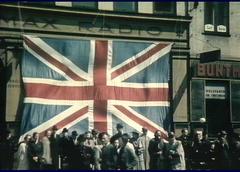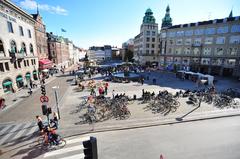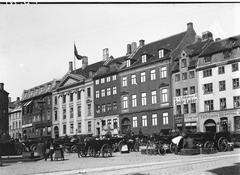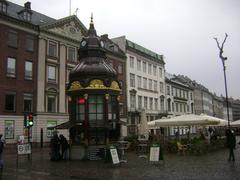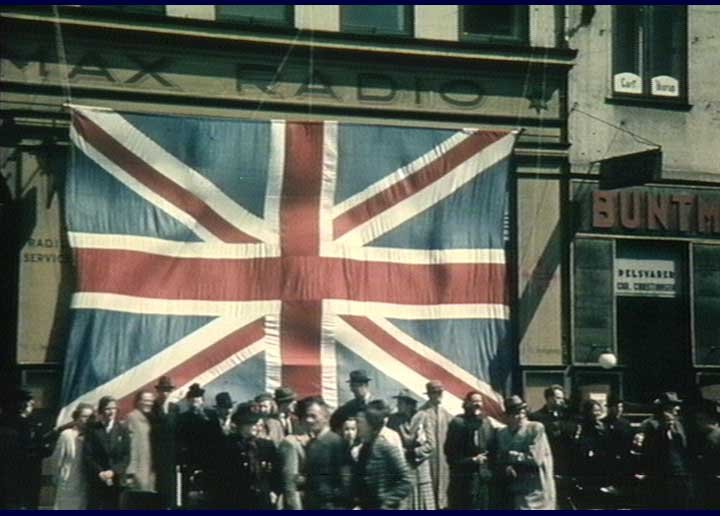
Nytorv Copenhagen: Visiting Hours, Tickets, and Comprehensive Tourist Guide
Date: 14/06/2025
Introduction
Nytorv, situated in the vibrant heart of Copenhagen’s historic city center, is an iconic public square that encapsulates the city’s layered history, striking architecture, and dynamic civic life. Established in the early 17th century, Nytorv—meaning “New Square”—has evolved from a bustling meat marketplace and a site of public justice to a celebrated focal point for festivals, gatherings, and everyday social interaction. Its Neoclassical architecture, notably the Copenhagen Court House, and its proximity to major attractions such as Strøget, Gammeltorv, and Nyhavn, make it an essential stop for anyone eager to experience Copenhagen’s heritage and urban vitality.
This guide offers a detailed overview of Nytorv’s origins, architectural and social significance, visiting hours, ticketing, accessibility, and practical tips. It also highlights cultural events, safety, and etiquette, equipping visitors with everything needed for a memorable visit to this remarkable Danish landmark.
For updated details on events and guided tours, visit the official Visit Copenhagen website or download the Audiala app for mobile guides and local insights.
Table of Contents
- Introduction
- History and Urban Development
- Architectural Significance
- Social and Cultural Life at Nytorv
- Visiting Hours and Ticket Information
- Accessibility and Traveler Facilities
- Safety and Local Etiquette
- Nearby Attractions
- Practical Visitor Tips
- Frequently Asked Questions (FAQ)
- Summary and Recommendations
- References
History and Urban Development
Origins and Early Role
Founded in 1610 under King Christian IV’s urban renewal plan, Nytorv was designed as a designated meat market, complementing the older Gammeltorv square. It quickly became an important hub for both trade and civic administration. Its function as a public justice site—with executions and punishments held in full view—cemented its place in Copenhagen’s collective memory.
The Great Fire and Rebuilding
The devastating fire of 1795 destroyed much of central Copenhagen, including Nytorv and Gammeltorv. The two squares were rebuilt with Neoclassical restraint, and the Copenhagen Court House (Domhuset) was constructed from 1805 to 1815, designed by Christian Frederik Hansen. This transformation shifted Nytorv’s focus from commerce and punishment to governance, justice, and civic pride.
Modern Evolution
Throughout the 19th and 20th centuries, Nytorv continued to evolve. Refurbishments in the 1990s further enhanced its role as a public gathering space, with features such as the octagonal podium marking the scaffold’s former site and the paving stones outlining historic buildings. Today, Nytorv is a seamless part of a pedestrian-friendly cityscape, popular for festivals, markets, and daily social life.
Architectural Significance
Copenhagen Court House
The Neoclassical Domhuset is Nytorv’s defining landmark, with its grand portico, Ionic columns, and harmonious proportions. Built after the 1795 fire, it symbolizes the square’s shift to civic authority. The building often offers guided tours, which provide architectural and historical insights.
Urban Layout and Surrounding Buildings
Nytorv’s integration with Gammeltorv, the Strøget pedestrian street, and a variety of 18th- and 19th-century buildings creates an open, flexible urban space. The square’s design accommodates both everyday use and major events, reflecting centuries of thoughtful urban planning.
Social and Cultural Life at Nytorv
Civic Gatherings and Events
Nytorv has always been a venue for public life—hosting everything from legal proceedings and protests to seasonal markets and festivals, such as the Copenhagen Jazz Festival and the Christmas Market. Its central location ensures a constant flow of pedestrians, shoppers, and performers, making it a lively meeting point.
Cultural Heritage and Memorials
A memorial plaque commemorates philosopher Søren Kierkegaard, who once lived here, adding to the square’s cultural significance. The octagonal podium and paving markers serve as tangible links to the square’s layered history.
Visiting Hours and Ticket Information
- Nytorv is open 24 hours a day, 7 days a week.
- There is no entrance fee or ticket required to visit the square.
- Tours of the Copenhagen Court House and other nearby sites may require advance booking and tickets; check official websites for details.
Accessibility and Traveler Facilities
Physical Accessibility
Nytorv’s flat, open layout ensures easy access for wheelchair users and those with mobility challenges. The square connects directly to Strøget and nearby attractions via wide, smooth pavements. Some cobblestone areas exist, but main routes are accessible.
Public Transport and Parking
- Closest metro stop: Kongens Nytorv (step-free access, elevators).
- Bus stops nearby serve multiple city routes.
- Designated disability parking is available; check local regulations.
Services
- Accessible restrooms are available in adjacent buildings and shopping centers.
- The Copenhagen Tourist Office (Vesterbrogade 4B) is fully accessible.
- Mobility aids can be rented locally (wonderfulcopenhagen.com).
Safety and Local Etiquette
Safety
Nytorv is one of Copenhagen’s safest public spaces: well-lit, regularly patrolled, and with low crime rates. As in any busy area, keep an eye on personal belongings, especially during crowded events.
Etiquette
- Greet with a polite “hej.”
- Tipping is not required but appreciated (round up or 5–10% for excellent service).
- Respect queues, public spaces, and keep noise moderate.
- Ask permission before photographing people.
- Smoking is banned indoors except in designated areas.
Nearby Attractions
- Gammeltorv: Adjacent historic square.
- Strøget: One of Europe’s longest shopping streets.
- Nyhavn: Picturesque harbor area with restaurants and canal tours.
- Round Tower (Rundetårn): Historic observatory.
- Christiansborg Palace: Seat of Danish Parliament.
- Rosenborg Castle: Home to crown jewels.
(travelinculture.com), (josephineremo.com)
Practical Visitor Tips
- Currency: Danish Krone (DKK); cards widely accepted.
- Wi-Fi: Public Wi-Fi available in nearby cafés and public areas.
- Tourist Office: Maps and assistance at Vesterbrogade 4B.
- Weather: Pack layers and rain gear.
- Best time to visit: May–September for outdoor events; December for festive markets.
- Guided tours: Free and paid tours, including history, food, and art, often start here (guruwalk.com).
Frequently Asked Questions (FAQ)
Q: What are Nytorv’s opening hours?
A: Nytorv is a public square open 24/7 with no entrance fees.
Q: Are tickets required to visit Nytorv?
A: No. The square is free; some surrounding attractions may charge admission.
Q: Is Nytorv accessible for wheelchair users?
A: Yes, with smooth pavements and accessible public transport nearby (motion4rent.com).
Q: What are the best nearby attractions?
A: Gammeltorv, Strøget, Nyhavn, Round Tower, Christiansborg Palace, Rosenborg Castle.
Q: Are guided tours available?
A: Yes, check local providers and the tourist office for schedules.
Summary and Recommendations
Nytorv is a living testament to Copenhagen’s resilience, culture, and commitment to accessible urban life. Open around the clock and free to all, it serves as a crossroads of history, architecture, and contemporary city living. Plan your visit to coincide with seasonal events, explore the adjacent squares and streets, and consider a guided tour for deeper insight. For up-to-date events, accessibility services, and guided itineraries, use the Visit Copenhagen website and the Audiala app.
Experience Nytorv—where the past and present of Copenhagen meet.
References
- Visit Copenhagen: Nytorv
- Nomad Epicureans: 2 Days in Copenhagen
- TravelInCulture: 3 Days in Copenhagen
- Wonderful Copenhagen: Accessibility Information
- Travellers Worldwide: Is Copenhagen Safe?
- GiveHowMuch: Tipping in Copenhagen
- Motion4Rent: Copenhagen Wheelchair Guide
- Josephine Remo: 2 Days in Copenhagen
- Guruwalk: The Wonders of Copenhagen
